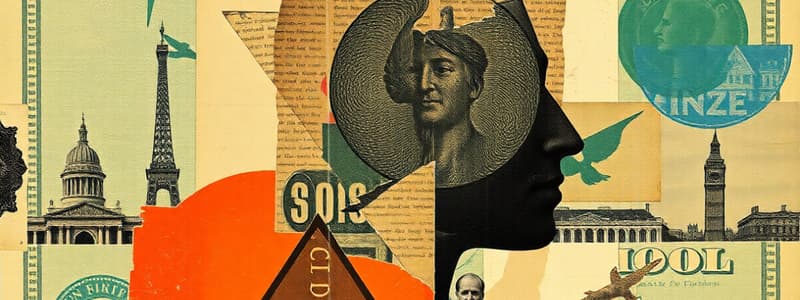Podcast
Questions and Answers
What can excessive seigniorage potentially trigger?
What can excessive seigniorage potentially trigger?
- Currency stabilization
- Increased public confidence
- Inflationary spiral (correct)
- Economic growth
What effect does excessive use of seigniorage for government spending have on public perception?
What effect does excessive use of seigniorage for government spending have on public perception?
- It has no significant effect
- It strengthens public trust
- It enhances the value of the currency
- It erodes public confidence (correct)
How does economic instability affect seigniorage?
How does economic instability affect seigniorage?
- It has no effect
- It guarantees successful monetary policies
- It complicates government leverage of seigniorage profits (correct)
- It enhances the profits from seigniorage
What is crucial for the management and use of seigniorage?
What is crucial for the management and use of seigniorage?
What is seigniorage in the context of monetary policy?
What is seigniorage in the context of monetary policy?
What is seigniorage primarily defined as?
What is seigniorage primarily defined as?
Which type of seigniorage is adjusted for changes in price level?
Which type of seigniorage is adjusted for changes in price level?
What can significantly affect the amount of seigniorage a government can generate?
What can significantly affect the amount of seigniorage a government can generate?
How can high levels of seigniorage lead to economic issues?
How can high levels of seigniorage lead to economic issues?
What does nominal seigniorage measure?
What does nominal seigniorage measure?
Which factor can lead to greater seigniorage?
Which factor can lead to greater seigniorage?
What potential downside does excessive reliance on seigniorage create for a government?
What potential downside does excessive reliance on seigniorage create for a government?
Which of the following best describes monetary seigniorage?
Which of the following best describes monetary seigniorage?
Flashcards
Seigniorage
Seigniorage
The profit a government earns by issuing currency, essentially a 'printing money' benefit.
Inflationary Spiral
Inflationary Spiral
A dangerous cycle where increasing seigniorage leads to inflation, which in turn pushes the government to print more money.
Loss of Confidence (Seigniorage)
Loss of Confidence (Seigniorage)
When people lose trust in the value of the currency because of excessive seigniorage, leading to instability and a potential economic crisis.
Transparency and Accountability (Seigniorage)
Transparency and Accountability (Seigniorage)
Signup and view all the flashcards
Risks of Excessive Seigniorage
Risks of Excessive Seigniorage
Signup and view all the flashcards
Cost of Production (in relation to Seigniorage)
Cost of Production (in relation to Seigniorage)
Signup and view all the flashcards
Face Value of Currency (in relation to Seigniorage)
Face Value of Currency (in relation to Seigniorage)
Signup and view all the flashcards
Monetary Seigniorage
Monetary Seigniorage
Signup and view all the flashcards
Real Seigniorage
Real Seigniorage
Signup and view all the flashcards
Nominal Seigniorage
Nominal Seigniorage
Signup and view all the flashcards
Inflation's Impact on Seigniorage
Inflation's Impact on Seigniorage
Signup and view all the flashcards
Money Supply Growth and Seigniorage
Money Supply Growth and Seigniorage
Signup and view all the flashcards
Study Notes
Definition and Concept
- Seigniorage is the difference between the face value of a currency and its production cost.
- It's a profit earned by the issuing authority (e.g., a central bank or government) for creating money.
- This profit arises because the value of the money is greater than the cost of producing it.
- Physical currency has relatively low production costs (paper, ink, etc.).
- Digital currencies (e.g., cryptocurrencies) have even lower production costs, potentially increasing seigniorage.
- This profit can fund government expenditures or reduce other taxes.
Components of Seigniorage
- Production costs are key. These costs cover materials, labor, and infrastructure for banknotes or coins.
- Face value is the amount printed on the note or stamped on the coin.
- Seigniorage is the difference between these two values.
Types of Seigniorage
- Monetary Seigniorage: Overall seigniorage from altering the money supply (printing currency).
- Real Seigniorage: Seigniorage revenue adjusted for price level changes.
- Nominal Seigniorage: Seigniorage measured in its face value.
Factors Affecting Seigniorage
- Inflation: Higher inflation can increase seigniorage, but degrades the money's purchasing power.
- Money Supply Growth: The speed of money creation affects seigniorage potential.
- Demand for Money: Higher demand increases currency value, potentially affecting seigniorage.
- Production Costs: Currency creation costs (physical or digital) greatly influence seigniorage profitability.
Implications of Seigniorage
- Fiscal Policy: Seigniorage strongly influences fiscal decisions.
- Budget Deficit: Overreliance on seigniorage can create unsustainable deficits.
- Inflationary Pressures: High seigniorage, particularly from expanding money supply without production increases, fuels inflation.
- Monetary Control: Central banks regulate seigniorage practices and risks.
Challenges and Risks
- Inflationary Spiral: Excessive seigniorage can trigger inflation, reducing currency value.
- Loss of Confidence: Over-reliance on seigniorage for funding erodes public trust in the currency.
- Economic Instability: Unstable conditions hinder a government's ability to utilize seigniorage effectively.
- Transparency and Accountability: Clear, traceable, and accountable management of seigniorage is crucial.
Conclusion
- Seigniorage is a key concept in economics and monetary policy.
- Understanding its mechanisms, implications, and risks is vital for responsible economic governance.
Studying That Suits You
Use AI to generate personalized quizzes and flashcards to suit your learning preferences.
Description
This quiz explores the concept of seigniorage, the profit made by issuing authorities from creating currency. It covers the difference between currency's face value and production cost, and how this profit can impact government funding and taxes. Additionally, it delves into the components that contribute to seigniorage.


